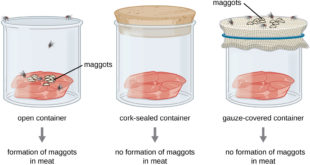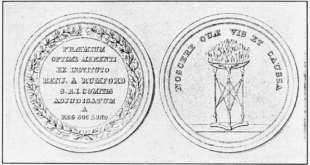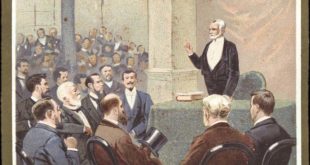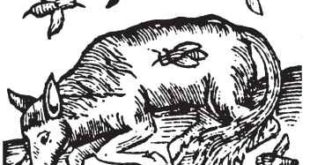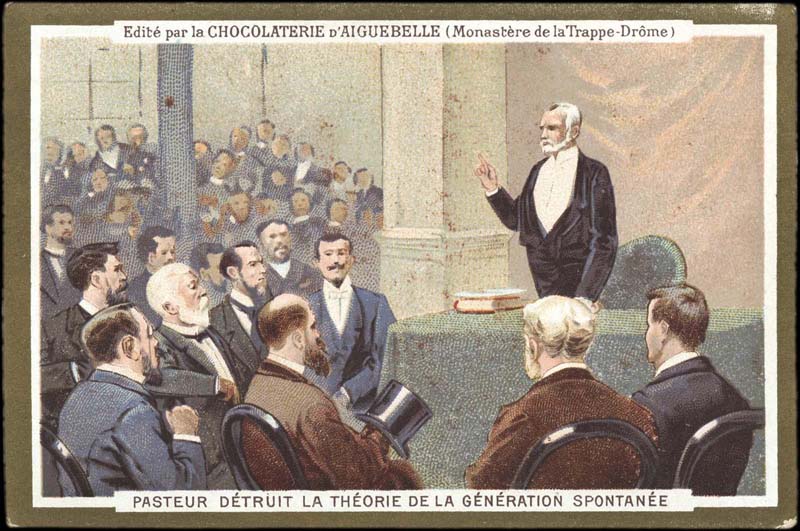
In the late 19th century, Louis Pasteur would find himself at the center of the spontaneous generation debate. However, it was only after centuries of conjecture, assumptions and the earlier scientific discoveries of others that Pasteur had the ability to put forth the crucial experiment that would uproot the theory of spontaneous generation.
From the time of the ancient Greeks and Romans, through the Middle Ages, and even into the late nineteenth century, it was generally accepted that some forms of life arose spontaneously from non-living matter. Spontaneous Generation or “equivocal generation” was the theory that life could arise from inanimate matter. This theory existed in several forms. The first form is referred to as abiogenesis or life arising from non-life. The second, heterogenesis, describes one form of life emerging from a different form.
Examples of Spontaneous Generation
Throughout history there are countless beliefs and theories regarding spontaneous generation, some unbelievable to the modern reader and some more understandable. Many occurrences of spontaneous generation appeared to occur in conjunction with decaying matter. A 17th century recipe for the spontaneous generation of mice required placing sweaty undergarments and husks of wheat in an open-mouth jar. Wait 21 days and, wallah, mice! Others believed that dust mites formed from dust itself. Anaximander (610-546 B.C.), a Greek philosopher believed that everything arose out of the elemental nature of the universe (wind, earth, fire, water). He claimed that living creatures were first formed in wet or liquid environments when acted upon by the sun. There were many other early philosophers with similar views of Anaximander, but it wasn’t until Aristotle that an in depth treatise was produced on the subject.
Aristotle and Spontaneous Generation
In his book The History of Animals, Book V, Part 1, Aristotle explicitly states his position regarding spontaneous generation:
Now there is one property that animals are found to have in common with plants. For some plants are generated from the seed of plants, whilst other plants are self-generated through the formation of some elemental principle similar to a seed; and of these latter plants some derive their nutriment from the ground, whilst others grow inside other plants, as is mentioned, by the way, in my treatise on Botany. So with animals, some spring from parent animals according to their kind, whilst others grow spontaneously and not from kindred stock; and of these instances of spontaneous generation some come from putrefying earth or vegetable matter, as is the case with a number of insects, while others are spontaneously generated in the inside of animals out of the secretions of their several organs.
Aristotle would go on to assert that shellfish would spontaneously generate from the material they grow in (sand, mud, etc.), a worm from snow and a grub from fire. At the center of Aristotle’s theory was the idea of pneuma or “vital heat.” It was the pneuma contained in the non-living material that had the power to generate life. This set the foundation for the theory of spontaneous generation that would exist for centuries to come.
Spontaneous Generation in Christianity
Some believe that Christianity openly adopted the theory of spontaneous generation. Biblical phrases such as, “Let the waters bring forth abundantly the moving creature that hath life” (Genesis 1:20), have been cited as examples of the theory’s existence in Chrisitan teachings. While I prefer not to delve into this subject here, it is this author’s humble opinion that not only does the idea of spontaneous generation in many ways contradict the ideas of the church, but that the Bible itself is rich with metaphorical explanations that many enjoy twisting into literal interpretation.
The Scientific Method and the Attack on Spontaneous Generation
Jan Baptist van Helmont
Even with science greatly increasing in accuracy and proficiency, there were still scientific processes that supported spontaneous generation. Jan Baptist van Helmont (1580–1644), a Flemish chemist, physiologist and physician produced several experiments in support of the idea of spontaneous generation. In one he showed that a willow tree after five years of growth, while the tree itself grew in size and bulk, the soil from which the tree was supposedly gaining its mass did not significantly decrease in matter. Therefore, it was attributed that the extra mass of the tree was spontaneously generating from another source. This was more due to a lack of understanding of photosynthesis rather than a proof of spontaneous generation. Helmont also had recipes for generating mice with soiled cloth and scorpions from basil, bricks and sunlight.
Francesco Redi
The time had come when these ancient beliefs would be put to the test. In 1668 the first serious attack on spontaneous generation came from an Italian physician named Frencesco Redi. He conducted a crucial experiment, outlined here, that delivered a devastating blow to the spontaneous generation proponents. Redi refuted the theory that maggots arise from decaying meat. He showed that the maggots in fact came from fly larvae laid directly on the meat. By covering the decaying meat and blocking access to the adult flies, he proved that decaying meat alone would never create maggots and that the exposed meat, when contacted by adult flies, would more often than not result in maggots.
John Needham
However, Redi’s experiment was not conclusive. Many viewed it as an isolated event, specific to decaying meat. In 1745 John Needham, another proponent of spontaneous generation, conducted a series of experiments with boiled broths. It was believed that by boiling the substance, any living organisms would be killed. After boiling the broth and sealing the container, the broth still continued to cloud, a clear indicator of life in the substance. For Needham, this was a sign that spontaneous generation was occurring even after boiling.
Lazzaro Spallanzani
Several decades later, in 1768, another Italian would lay forth a crucial experiment. Lazzaro Spallanzani modified the Needham experiment. He hypothesized that after Needham boiled the broth and placed it into the jar, the substance became contaminated. Spallanzani’s method involved boiling the broth in a sealed container with the ability for air to partially evacuate, preventing an explosion. He effectively defeated any growth in the broth time and time again. However, the spontaneous generation followers quickly redacted their theories, stating that Spallanzani only proved that spontaneous generation could not occur without air.
Pasteur’s Definitive Experiment
These back and forth debates and experiments continued for nearly another hundred years. It wasn’t until the mid 19th century and the introduction of the microscope, that the issue was finally put to rest.
In 1837 Charles Cagniard de la Tour, a physicist, and Theodor Schwann, one of the founders of cell theory, published their independent discovery of yeast in alcoholic fermentation. When the presence of yeast was negated, and only sterile air or pure oxygen was introduced into the substance, fermentation would never occur. This suggested that airborne microorganisms, not spontaneous generation, was the cause of fermentation. This was the advance that 20 years later would solidify Pasteur’s experiment.
Louis Pasteur did not defeat spontaneous generation himself. The ability to look back across history and see the developments that came before, gave him a great advantage. In 1859, it was a simple, yet genius experiment that sent the theory of spontaneous generation into the history books. Remember the important talking points in the debate:
- by boiling a substance you can kill all life forms
- a substance can still become “contaminated” after boiling
- exposure to air can cause contamination due to microorganisms
- air is the cause of spontaneous generation
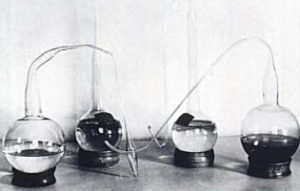
Pasteur knew what his experiment must do: show that a substance can be absent of all life and if properly protected no future living organisms will arise, even when exposed to air. Once the idea in his mind was clear, the experiment came to him naturally. Pasteur boiled the broth in a flask to kill all living organisms. He then heated the neck of the flask and bent it into the shape of an “S,” in theory preventing any organisms to pass into the broth, but allowing air to freely enter the flask. The broth never turned cloudy. It was only when Pasteur tipped the flask so that the broth would reach come into contact with the microorganisms that settled in the flask neck that the broth would become teeming with life. He had done it. Centuries of theory and conjecture had finally come to a definitive conclusion. Not only had Pasteur strengthened the theories of those before him, but he had taken all power from the spontaneous generation crowd. They had no new causes to hide behind, no experimental flaws to exploit.
While many had seen this experiment as the end of spontaneous generation’s long history, Pasteur saw something else. He had set science and medicine on a new course. He had shown that in fact their are microorganisms in the air, everywhere. Now it was clear and his work on Germ Theory would begin.
 Pasteur Brewing Louis Pasteur – Science, Health, and Brewing
Pasteur Brewing Louis Pasteur – Science, Health, and Brewing 